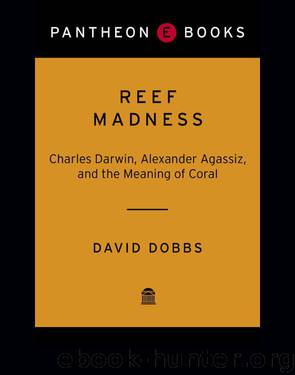Reef Madness by David Dobbs

Author:David Dobbs
Language: eng
Format: mobi, epub
ISBN: 9780307490070
Publisher: Knopf Doubleday Publishing Group
Published: 2005-10-14T10:00:00+00:00
4
Even as he was composing his Chile notes, Darwin was turning his mind west. The Beagle, having finished its laborious survey of the South American coast, was making ready to sail. Examining charts of the route ahead, Darwin contemplated the oddity that is the Pacific: a broad pan, immensely deep, with arcs and ovals and doglegs of coral isles rising, as he put it, from its “profoundest parts.” Several of these archipelagoes–the Galápagos, the Tuamotus, French Polynesia, the Fijis, and the Friendlys–lay along the Beagle’s route. In the sixty years since Captain James Cook had mapped them, these islands had commanded much interest among geologists and naturalists. They were intrigued by the great depths from which they rose; their volcanic nature; their ordered but irregular arrangements, like pearl necklaces tossed to the floor; and the islands’ distinctive annularity
Someone excited sleepless by geology wasn’t likely to resist such shapes. Darwin’s Andean wanderings and ruminations had whetted what would prove an insatiable appetite for discovering patterns spanning space and time. These ringed islands presented precisely such a pattern.
The puzzle seemed ripe for solution. Though coral islands and reefs had intrigued Europe’s scientists and public for almost a century (an interest greatly boosted by the descriptions Cook brought back of the South Pacific archipelagoes in the 1770s), no one had plausibly explained how they came to be. They were initially appreciated mainly for the sheer wonder of their existence, apparently climbing from the sea’s depths to create new landscapes. In the eighteenth-century fascination with the idea of a Great Chain of Being, corals held a special place for seeming to bridge the gap between plant and animal, and, after Jean-André Peyssonnel showed them to be animals in 1753, for creating with their calcified skeletons the huge structures that joined the organic and the inorganic worlds as well as sea and land. In the early nineteenth century, some saw in coral reefs a welcome antidote to the erosion that, according to Huttonian geology was erasing humankind’s terrestrial platform. “Whatever destroying tendencies … exist on the earth,” wrote one prominent geologist in 1818, “these renovating powers compensate for them.”
Such speculations rose naturally when geology was so young, the reefs so many, and scientific visits to them so few and brief. Naturalists on the Cook and other expeditions of the late 1700s, however, began to fill in the blanks. They established that the reefs were formed by the accumulating skeletons of huge colonies of tiny, tube-shaped animals known as coral polyps. These polyps, which would later be found to be hard-bodied cousins of sea anemones, were also variously referred to as insects, “molluscus worms,” or even “animalcules.” They seemed to live only in warm tropical waters, generally no further than twenty-five or thirty degrees from the equator. The polyps apparently built their great works extremely slowly. No one who lived in coral regions described discernible growth, and while nineteenth-century European visitors who compared the reefs to descriptions and charts from the previous century discovered that some reef areas had apparently been torn up by storms, they could not find measurable expansion.
Download
This site does not store any files on its server. We only index and link to content provided by other sites. Please contact the content providers to delete copyright contents if any and email us, we'll remove relevant links or contents immediately.
The Lonely City by Olivia Laing(4746)
Animal Frequency by Melissa Alvarez(4394)
All Creatures Great and Small by James Herriot(4231)
Walking by Henry David Thoreau(3892)
Exit West by Mohsin Hamid(3777)
Origin Story: A Big History of Everything by David Christian(3648)
COSMOS by Carl Sagan(3553)
How to Read Water: Clues and Patterns from Puddles to the Sea (Natural Navigation) by Tristan Gooley(3406)
Hedgerow by John Wright(3274)
The Inner Life of Animals by Peter Wohlleben(3259)
How to Read Nature by Tristan Gooley(3249)
How to Do Nothing by Jenny Odell(3232)
Project Animal Farm: An Accidental Journey into the Secret World of Farming and the Truth About Our Food by Sonia Faruqi(3177)
Origin Story by David Christian(3146)
Water by Ian Miller(3126)
A Forest Journey by John Perlin(3026)
The Plant Messiah by Carlos Magdalena(2881)
A Wilder Time by William E. Glassley(2818)
Forests: A Very Short Introduction by Jaboury Ghazoul(2790)
